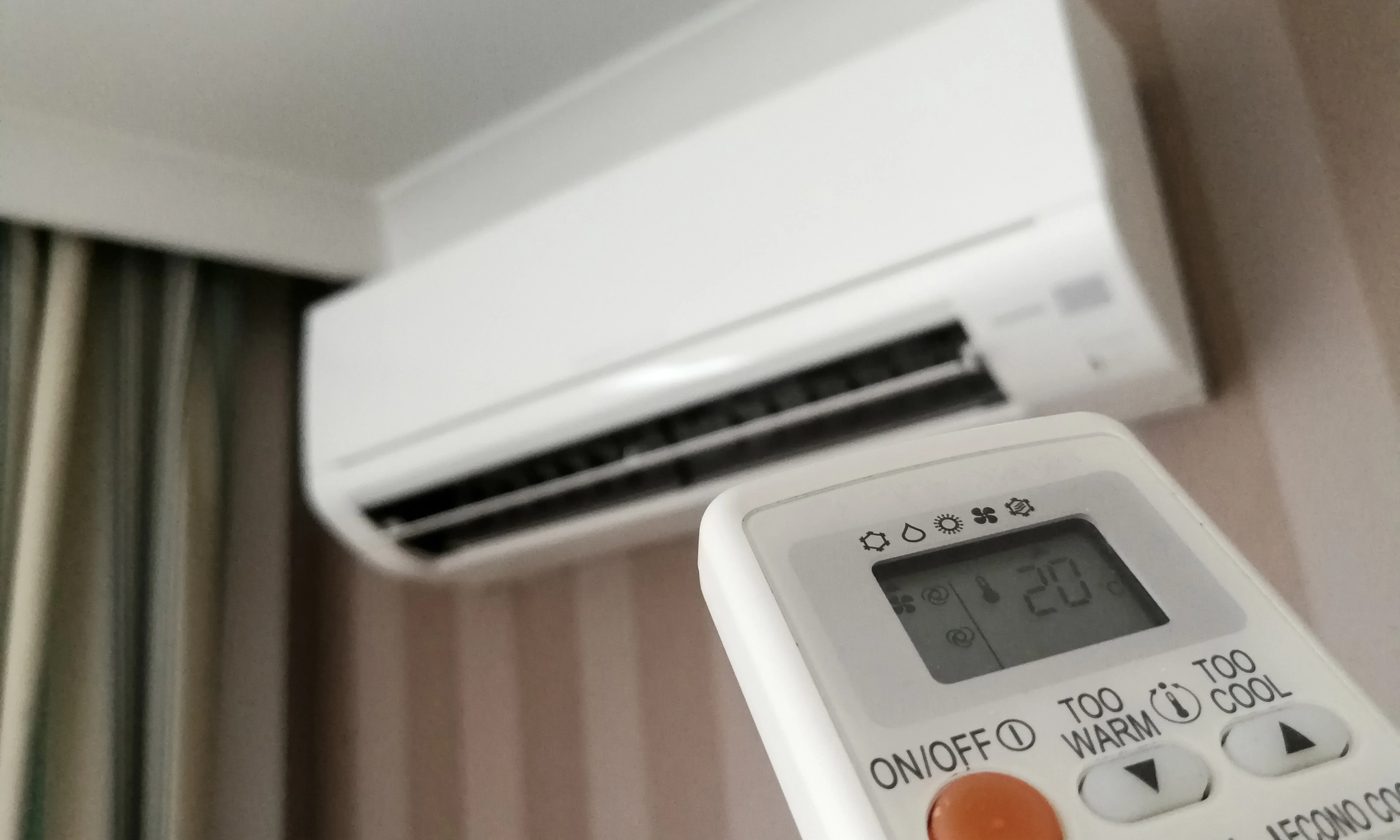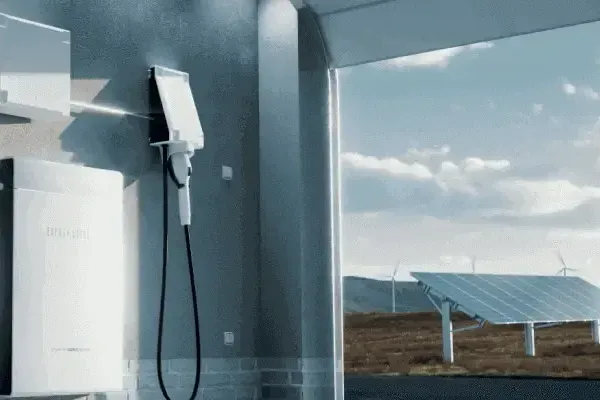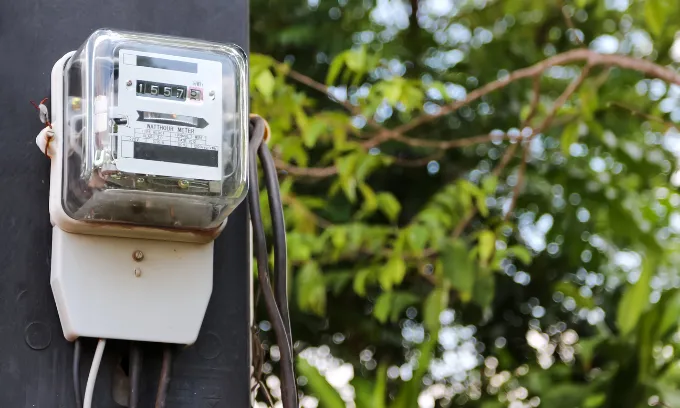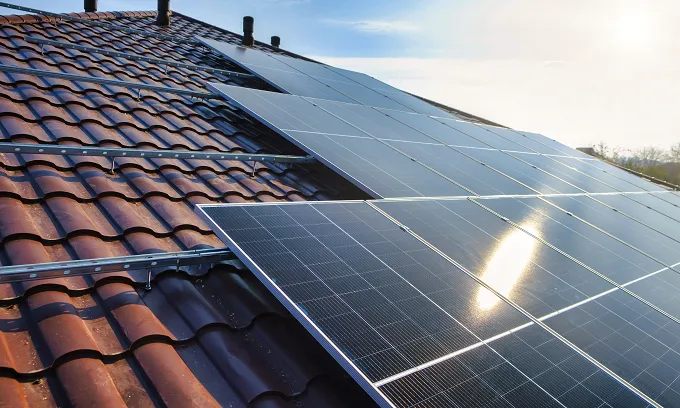What is energy efficient heating and cooling?
Energy efficient heating and cooling is the process of warming or cooling a space using less energy, including with energy efficient appliances such as heaters, air conditioners or fans.
An energy efficient appliance can effectively lower your power bill over time, possibly equalling hundreds of dollars in savings annually. That said, these appliances typically cost more to purchase.
Other benefits may include:
- Reduced carbon footprint: By relying less on fossil-fuel-derived electricity, you’re lowering your home's carbon footprint.
- Reduced strain on the grid: Less-demanding appliances put less pressure on the grid during peak periods, lowering the risk of power outages.
- Longer lifespan: Newer appliances are usually built with higher-quality, longer-lasting materials.
- Government rebates: Some state governments are expediting the switch to greener, energy-efficient appliances with generous rebates.
Should I buy energy efficient heating and cooling appliances?
Energy efficient appliances may be worth it if the long-term savings exceed the cost to buy them.
The time taken for long-term savings to cover the upfront cost is called its ‘payback period’.
If you don’t frequently use your appliance, its payback period will increase.
Energy efficient cooling explained
Types of cooling appliances
Fans
Fans rely on rotating blades attached to a turbine to circulate air, cooling the room by speeding up sweat evaporation.
- Uses the least electricity.
- Ineffective at cooling in humid climates and hot weather.
- Cooling limited by blade length.
- Can be used in open spaces.
Evaporative coolers
Evaporative coolers lower the temperature by emitting cool vapours through a series of ducts.
- Uses more electricity than fans.
- Cool effectively in drier climates.
- Not as effective in open spaces.
- Can help purify the air.
Air-conditioning
An air conditioner moves heat and humidity from a closed space to outside, returning colder and drier air inside.
- Uses significantly more electricity than fans and evaporative coolers.
- More expensive to buy than other fans and evaporative coolers.
- Excellent for cooling, lowering ambient temperature and humidity (especially if they have a dehumidifier mode).
- Works effectively in all climates
- Does not cool well in open spaces.
- Lasts up to 20 years with regular maintenance.
Which cooling appliance should I buy?
If your decision is based strictly on lowering your total energy use, a fan may be your best choice.
Ultimately, most Australians will pick an appliance that ticks off their cooling needs before moving on to energy efficiency.
If you’re buying a cooling appliance for the first time, it’s important to assess the area you’d like to cool and your personal needs:
- Is the space you’d like to cool open or closed, outdoors or indoors?
- Do you live in a dry or humid climate?
- Are the summer seasons especially hot?
- How frequently will you use the appliance?
- How much are you willing to spend upfront?
Energy efficient fans
A fan’s motion relies on either a DC or AC motor. A fan with a DC motor is typically more energy efficient.
Fans typically come in multiple forms, which also affects their overall energy consumption.
Name | Description | Pros | Cons |
|---|---|---|---|
Pedestal fan | A height-adjustable, standing fan with a rotating and tilting head. |
|
|
Tower fan | A slim and vertical fan with concealed blades. |
|
|
Ceiling fan | A ceiling-mounted electrically powered fan that circulates air. |
|
|
Energy efficient fan features
Energy label rating
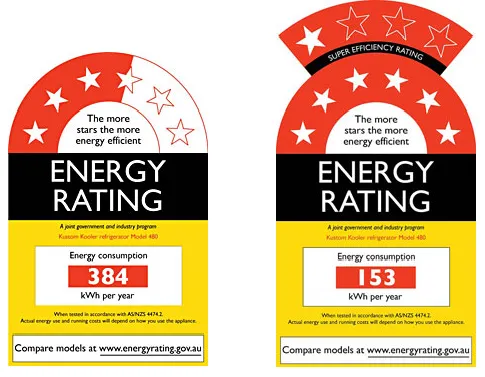
Source: Energy Rating, Australian Government
Fans will be marked with an Energy Label Rating sticker on the front or back (near the motor), which can be split into two parts:
- Star ratings: Uses a scale ranging from zero to five stars; the more stars awarded, the more energy efficient the appliance.
- Energy consumption: Measures how much electricity a fan uses annually in kilowatt hours (kWh). Standardised from a fixed usage pattern — how much energy your appliance uses may differ.
Power rating
A power rating in watts (W) indicates how much power a fan requires to run. A higher power rating means a more power-hungry fan. The rating can be found on the fan’s plug, behind the motor, or on its packaging.
Energy efficient fan settings
- Your fan’s settings: The lower the speed settings, the more energy you save.
- Usage duration: Leaving your fan spinning constantly increases your overall power consumption. Turn it off when it isn’t in use. Alternatively, if your fan has a built-in timer, set it to your preferred runtime.
- Cleaning your fan: Frequently clean your fan’s blades and motors to help improve energy efficiency and lower the chances of overheating.
Energy efficient evaporative coolers
Evaporative coolers exist in portable, mounted and ducted variants.
Name | Description | Pros | Cons |
|---|---|---|---|
Portable evaporative cooler | A cooler that’s compact and wheeled. |
|
|
Wall-mounted evaporative cooler | Evaporative coolers designed for warehouses, stadiums and schools. | ||
Ducted evaporative cooler | An entire-home evaporative cooler with a series of ducts for separate rooms and living spaces. |
|
|
Energy efficient evaporative cooler features
Energy Label Rating
Note: Any references to heating in the label below do not apply to evaporative coolers.
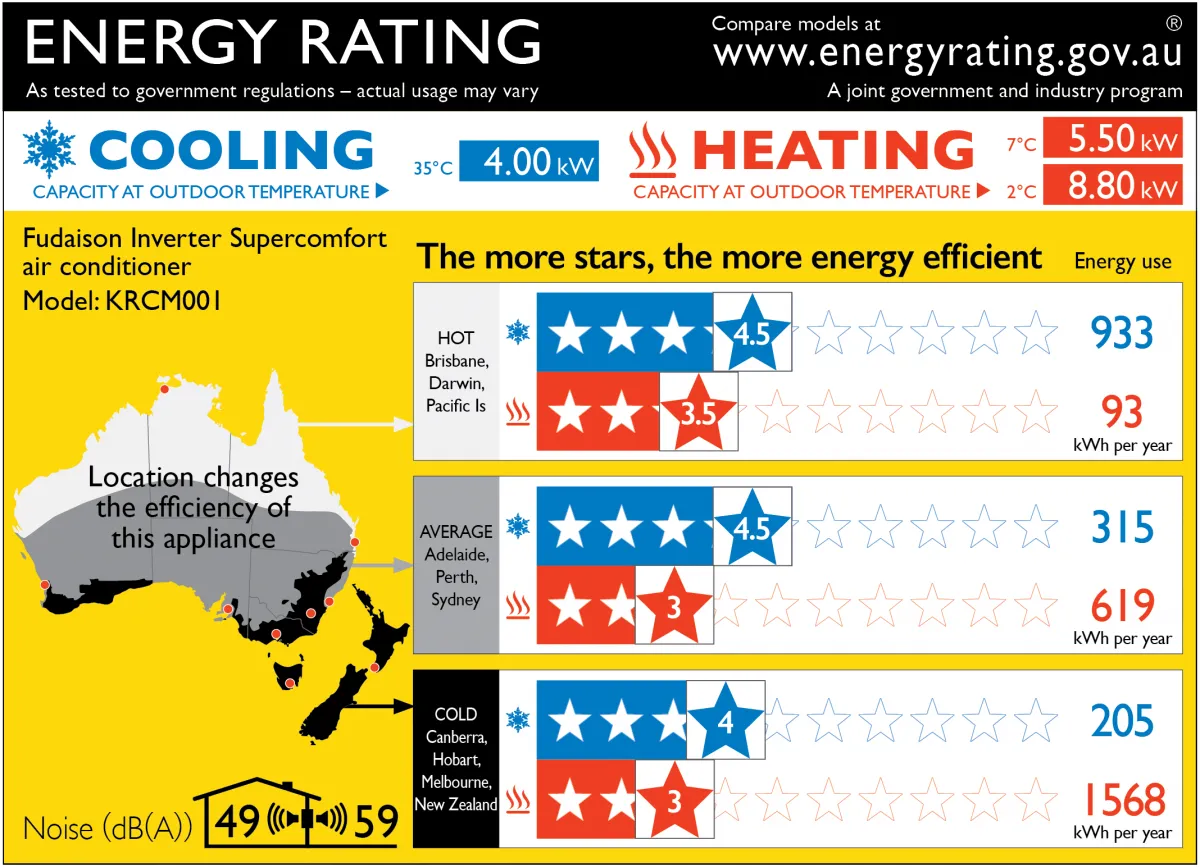
Source: Energy Rating, Australian Government
Unlike fans, evaporative coolers and air conditioners share a unique energy label design:
- Star ratings: More stars (out of ten) mean the fan uses less energy. There are separate star ratings for each climate zone (broken down by state).
- Energy consumption: How much electricity an evaporative cooler uses per year (in kWh). Each standardised figure differs between each climate zone and state.
Power rating
A higher power rating or wattage equals a more power-intensive cooler. An evaporative cooler’s wattage can be found on its back, side or even on its plug, measured in watts (W).
Speed settings
A ducted system with higher speed settings will use more electricity to circulate cool air throughout your home.
Using your efficient evaporative cooler
- Your evaporative cooler’s settings: Like a fan, the lower you set its speed, the more power you’ll save.
- Usage duration: Turn it off when not in use or set its programmable feature to turn on and off at your preferred times.
- Shutting doors and windows: Leaving windows and doors open will strain your cooler as it drains more power to maintain a constant temperature. Seal off any openings that can cause cool air to escape.
Energy efficient air conditioning
The most efficient air conditioners tend to be reverse-cycle (also known as a heat-pump). However, reverse-cycle air conditioners exist in multiple forms:
Name | Description | Pros | Cons |
|---|---|---|---|
Portable air conditioner | A freestanding unit for smaller spaces. |
|
|
Split system air conditioner | Channels a liquid refrigerant through the system to cool the air. Comes in two separate parts – an indoor unit and an outdoor compressor. |
|
|
Ducted-air conditioner | Works through a series of ducts connected to an internal unit, installed either in the roof or under the floor of a home. The ducts run to each room of the house, allowing you to cool each space using individual controls, or “zoning”. |
|
|
Energy efficient air conditioning features
Energy label rating
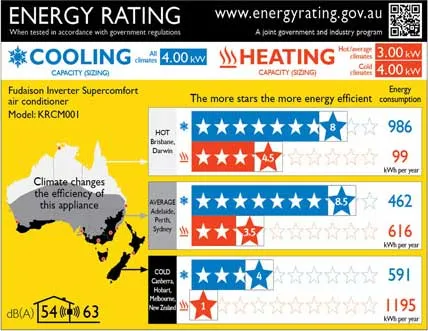
Source: Energy Rating, Australian Government
As we previously mentioned, air conditioners have a more complex energy label than fans and evaporative coolers.
- Star ratings: More stars (out of six or ten) mean it uses less energy. Different star ratings are given to each climate zone.
- Energy consumption: How much electricity an evaporative cooler uses per year (in kWh). Each standardised figure differs between each climate zone and state.
- Heating: A star rating and energy consumption estimate for heating is also given for each climate zone, which only applies to reverse-cycle air conditioners.
Power rating
An air conditioner’s power rating in watts (W) can be found on a sticker on its front or side. A higher power rating equates to a higher power consumption.
Using your energy efficient air conditioner
- Temperature setting: According to the Department of Climate Change, Energy, the Environment and Water, every extra degree of heating and cooling will increase your energy consumption by 5–10%. Depending on your state and region, the best temperature for energy efficiency is typically:
- Summer: 22-24 ℃ for cooling
- Winter: 19-21℃ for heating
- Fan speed setting: Setting a higher fan speed will drain more electricity to circulate chilled air. You could consider lowering the fan speed or using a separate fan to circulate chilled air throughout the area.
- Sealing and insulation: If the space you’re trying to cool is poorly sealed or insulated, your air conditioner will have to work harder to reach the set temperature. Make sure the doors, openings and windows are sealed shut.
- Maintain your air conditioning unit/s: If your home isn’t being cooled or heated properly, your air conditioner may need to be serviced. Coil blockages or dirty filtration could cause the unit to work doubly hard.
- Usage duration: A timer can help to ensure that the air conditioner is only running when someone is at home.
Energy efficient heating explained
Types of heaters
Fan Heaters
Fan heaters operate by fanning heated air (circulated over a heating element) into a room.
- Use a lower amount of electricity.
- Fairly affordable, ranging from $30 to $250.
- Only suitable for smaller spaces.
- Quick to heat up, but stops radiating heat immediately after turning off.
- Heat can be oscillated or fanned.
- Exposed elements can be a safety risk.
Convection Heaters
Convection heaters, also known as convector heaters, are electric-powered heaters that draw cold air in (convection currents) over a heating element before passing it back into the room.
- Not as energy efficient as radiant or fan heaters.
- Cost more than radiant heaters, starting from $50 for smaller units and reaching up to $500.
- Quick to warm up.
- Only provide targeted heating.
- Can overheat if the fan fails or is damaged.
- Can take longer to heat a room if there’s a cold draft.
- No exposed heating elements.
Radiant bar heaters
Radiant bar heaters radiate heat outward using infrared rays generated by several bars built into the heater.
- Use a lower amount of electricity.
- Can be affordable, ranging from $60 and reaching up to $1,000.
- Only suitable for localised spaces.
- Limited temperature control settings.
- Stop radiating heat as soon as they are turned off.
Oil column heaters
Oil-filled heaters, also known as column heaters due to their distinctive design), produce radiant heat. Oil-filled and oil-free radiators are available.
Once plugged in, the heater warms and circulates oil throughout the columns, producing heat.
- Provide long-lasting heat
- Suitable for large rooms.
- Slower to warm up than other portable heaters.
- Large in size and heavier than the alternatives.
- Hot to the touch.
- Costly to repair.
Reverse cycle air conditioners
Reverse cycle air conditioners can be used for heating in winter and for cooling in the summer.
- More energy efficient than portable heaters.
- Doors and windows need to be closed for maximum efficiency.
Gas heaters
A gas heater is fueled by butane, propane, liquified petroleum gas (LPG) or natural gas. The heater is connected to a source of gas and its flow is controlled through a valve. Heat is ignited via an electric filament or pilot light.
If your home isn’t connected to a gas network, you can contact the distributor in your state and area to set one up for a fee. However, if your home isn’t close enough to a gas mains, LPG heaters are also an option.
Overview:
- Most energy efficient heater type.
- Most expensive heater type to buy.
- Quick to heat up.
- Can generate enough heat to warm your entire home.
- More environmentally friendly than electric heaters.
- Can last up to 20 years with regular maintenance.
- Require professional installation.
- Potential safety risk in case of a carbon monoxide leak.
- Produce water vapour which can lead to condensation and mould.
Which energy efficient heater should I choose?
The heater types that use the least amount of energy are a reverse-cycle air conditioner or a gas heater.
Most Australians will pick a heater that satisfies their needs before focusing on energy efficiency.
If you’re buying a heating appliance for the first time, it’s crucial to consider your living situation before making a choice:
- How big is the space you’d like to heat?
- Do you have children living with you who may touch exposed elements in oil column or fan heaters?
- Do you have a gas connection at home?
- How much money do you want to spend upfront?
Don’t forget to account for anything that adds to the purchase and installation costs of any heater. The more you spend upfront, the longer the payback period.
Energy efficient heater features
Energy Label Rating for electric heaters
Regardless of heater type, every new heater should come with an energy label rating stuck to its side, back or front:
- Star ratings: More stars (out of six or out of ten) mean the fan uses less energy. Different star ratings are given to each climate zone (categorised by state).
- Energy consumption: This is how much electricity an evaporative cooler uses per year (in kWh). Each standardised figure differs between each climate zone and state.
Energy Label Rating for gas heaters
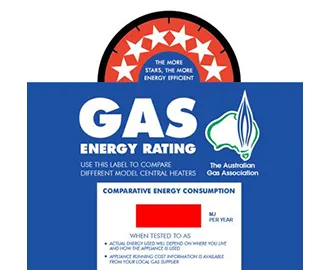
Source: Sustainability Victoria
Gas energy rating labels exclusively apply to gas heaters and gas water heaters. They function the same way as an Energy Label Rating and their fixed annual gas usage is measured in megajoules (MJ).
Power rating
Electrical heaters will have a power rating (in W) on their plug or on the back of the unit.
Gas heaters will also have a power rating located on the unit’s front/back or sides. However, instead of watts, their power ratings are measured in megajoules (MJ).
A higher rating reflects a more power-intensive unit. However, that could also indicate a more powerful heater.
Using your energy efficient heater
- Temperature control: Energy Australia recommends keeping heating to 18 and 20 degrees Celsius to balance comfort and energy efficiency.
- Usage duration: Most heaters and air conditioners allow you to set your preferred hours of operation through their built-in timers.
- Shutting doors and windows: Close the doors and windows to the space you’re heating to prevent hot air leaks.
- Frequent cleaning: Removing dust or dirt buildup increases a heater’s overall energy efficiency.
What other ways can I efficiently cool or warm my home?
Winter tips
- Get the most out of the sun: Open up blinds and allow the sun’s heat to warm your home..
- Put on more layers: Wear a thermal jacket, sweater or blanket to trap more body heat.
- Installing insulation: Consider installing double-glazed windows and wall insulation.
Summer tips
- Close the curtains: In the middle of the day, close your blinds and curtains to keep natural heat from entering your home.
- Open your windows and doors: Leave your doors and windows open if the temperature outside is cooler than it is inside (unless you’re using air conditioning).
- Wear comfortable clothing: Wear cotton or dri-fit clothes to wick away moisture. Tank tops or shorts will also cool you down faster.
- Installing insulation: Insulation slows the transfer of heat, keeping the sun's heat out and your cool air in.
Will energy efficient heating and cooling lower my energy bill?
Reducing your energy usage can help lower your bills, but you’ll still have to consider the actual rates you’re paying for your electricity or gas.
If you’re on an energy plan with high base rates, you’ll be left overpaying for every kWh of electricity or MJ of gas used.
Switching to an energy-efficient appliance is the first step - but don’t forget to compare electricity and gas plans to find a better deal.



